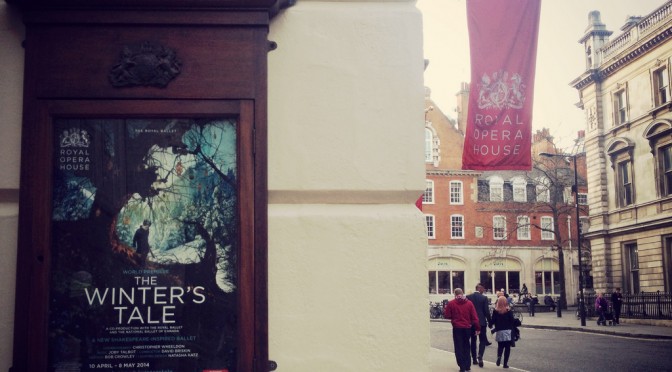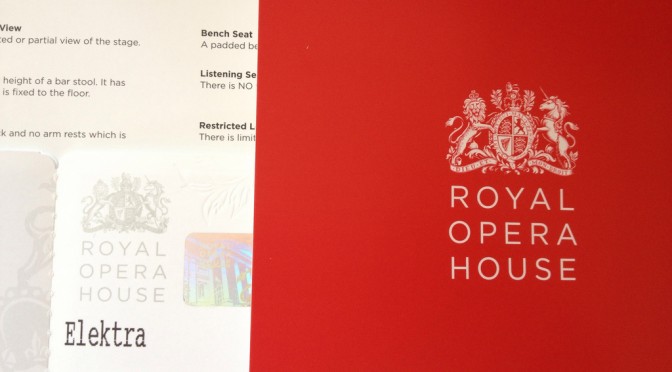I don’t expect this to be happening too often (I am a bit of a nag) but this is a post where I’m going to be raving about EVERYTHING.
If you know me (some people have been reading me for a number of years through my other online activities) and trust me (a smaller percentage no doubt) you only need to know this: DO EVERYTHING IN YOUR POWER to watch The Winter’s Tale. There.
For the rest, here is my view.
The Winter’s Tale is a new ballet by Christopher Wheeldon, the extraordinary choreographer who took the world by storm with his Alice in Wonderland a few years back. Sadly I missed that and I was not about to repeat the same mistake. Clutching my £22 tickets for the Upper Amphitheatre (here’s my trick for getting cheap-er tickets) I sat down on time, leafing through the programme.
Apparently, reading your programme before the performance is recommended (honestly, Wheeldon says so himself in the interview included). This is because the man is choreographing Shakespeare. I chuckled when I read that, I read my programme before watching Shakespeare in theatre, let along in ballet.

The Winter’s Tale (read the synopsis here) as realised by Wheeldon and as understood by yours truly, is basically about the catastrophic effects of jealousy and the paranoia associated with it, as well as its repercussions across the years and lives of all it affects.
Sure, there is a redemption – of sorts – in the end but there are always the scars of catastrophic past actions. This seeps through the choreography, with essentially a new language being developed here (very Shakespearean that, in a way). Classical movement, modern movement, amazing pas des deux and simply breathtaking choreography for the corps de ballet – with the brilliant dancers to match.
Edward Watson as Leontes is the amazing “spider king” – an eloquent and very accurate description by Molly Flatt on twitter.
The man has the grace and pathos to pull this off and then some. I saw him in Mayerling last year and he was the main reason I was glued to my seat. Watson as Leontes in The Winter’s Tale embodies the paranoia of jealousy as well as the heart-rending guilt and remorse. Their pas de deux with Cuthberson when she is finally revealed to be alive (not much of a spoiler, but sorry about that) is immensely powerful.
Cuthbertson as Hermione just excels in a very strong and at times claustrophobic role and Yanowsky as Paulina pulls the strands of grief (and a bitter joy) together brilliantly and expressively.
My personal favourites are Steven McRae and Sarah Lamb. They bring a tenderness of sorts to the stage, a sense of youth and energy. Their pas de deux is vibrant, their expressions soft, their concern for each other is very touching.


I mean just look at this photo! Look at the precise movement, so beautifully choreographed, their perfect lines, the tender hold, the girly abandon. That woman can play 16 likes nobody’s business and that guy has an energy that shouts “I am young and will never die”.
The jealousy that sets everything in motion is not only brilliantly realised by the choreography but brought to life by the music too. Joby Talbot composed a near perfect ballet score (I can’t say ‘perfect’ cause I just don’t know music). The paranoia just flows through the instruments, it’s quite unnerving. My favourite feature of the score though was the use of an on-stage band (very Chicago revival style) for the Bohemian May celebration scenes and the use of what I think was the santouri (or something similar), which has a distinct melodic and very nostalgic sound. Correct me if it was a different instrument please.
Apart from the brilliant choreography and music, lighting plays a huge role here. I can’t remember the last time I was so excited by the lighting design. It perfectly matches the tone, sets the mood, takes the audience along on an amazing journey – this is all the work of the brilliant Natasha Katz.
Finally, I really do have to mention the designs. (Designs by Bob Crowley, Silk Effects Designer – Basil Twist and Projection Designer Daniel Brodie). This is where the whole thing comes together. The contradiction of the two countries, the sea journeys, the ships and last but not least one of Shakespeare’s most famous stage directions: “Exit, pursued by a bear.” But I’m not giving you any spoilers on that. And seeing how tickets seem to have disappeared you will probably have to wait for the DVD.
With: Watson, Cuthbertson, Lamb, Yanowsky, McRae, Bonelli.
——————————
Disclosure: Watched The Winter’s Tale on 28 April 2014 and paid for my ticket. No prior discussion with the venue took place.
——————————





Hi Sofia,
Thanks for noticing the instrument you describe as a Santouri. I was playing it. The score asks for a Dulcimer. Hammered Dulcimer is a generic term for instruments that appear in most cultures around the world and I think the Greek form is a Santouri. In actual fact the music for The Winter’s Tale could not be played on any of them for various reasons and an instrument had to be custom made, a combination of a cimbalom and a dulcimer. I have named it a Dulcilom. I am pleased you enjoyed the show. Best wishes, Greg
Hello Greg! Thanks very much for taking the time to respond and congrats for your lovely performance. The sound of your Dulcilom (I love that you named it) really reminded me of the Greek Santouri – it is extremely loved in Greece and its sound is mainly associated with nostalgic old songs (mainly from the islands and Asia Minor).
Hope to catch you on stage again soon!
Hi Sofia,
So glad that you noticed and appreciate the Dulcilom, I am the maker. There are not many people making instruments like this in the UK. In many ways this is very like a santouri although made very much lighter so as to be relatively easy to carry around. Tim
Hello Tim! Thank you so much for the comment. I have to say, I don’t know music that much but the sound was magical!